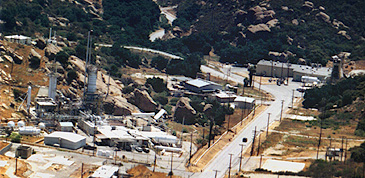 SACRAMENTO - Health researchers have linked on-the-job radiation exposure
to excessive cancer deaths among workers at Rocketdyne's Santa Susana Field
Laboratory, the Daily News has learned. SACRAMENTO - Health researchers have linked on-the-job radiation exposure
to excessive cancer deaths among workers at Rocketdyne's Santa Susana Field
Laboratory, the Daily News has learned.
-
- In a long-awaited study set to be made
public today, UCLA scientists and state health officials will report that
the cancer risk to workers exposed to low doses of radiation at the Simi
Hills facility is at least six to eight times higher than previous studies
suggested.
-
- Their long-term study of 4,600 Rocketdyne
workers found higher than expected death
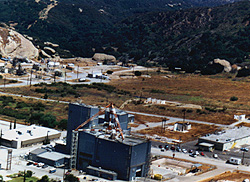 rates from a wide variety of cancers, including leukemia and lung
cancer, according to documents obtained by the Daily News. rates from a wide variety of cancers, including leukemia and lung
cancer, according to documents obtained by the Daily News.
-
- Though the exact numbers of cancer deaths
found were not available, researcher found work place radiation responsible
for 27.3 percent of such deaths among workers who inhaled or ingested radioactive
particles, the documents state.
-
- "Clearly, if I were a worker at
that facility, it would get my attention," said one official familiar
with the report. "It's fairly blunt for a scientific study."
-
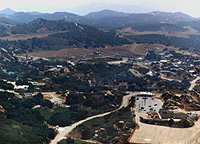 The study is the culmination of eight
years of controversy since the Daily News disclosed May 14, 1989, that
a study for the U.S. Department of Energy found radioactive chemical contamination
in the soil at Rocketdyne's Santa Susana Field Laboratory in the hills
between Chatsworth and Simi Valley. The study is the culmination of eight
years of controversy since the Daily News disclosed May 14, 1989, that
a study for the U.S. Department of Energy found radioactive chemical contamination
in the soil at Rocketdyne's Santa Susana Field Laboratory in the hills
between Chatsworth and Simi Valley.
-
- The U.S. Environmental Protection Agency
stepped in and assumed oversight of the cleanup program at the 2,600-acre
facility where nuclear research was conducted for four decades under DOE
contracts. A $55 million cleanup is under way.
-
- At the time of the 1989 disclosure, there
was no evidence of a health threat to workers or the public.
-
- But under community pressure the epidemiological
study was ordered and a key recommendation of the report today is that
a second study be considered to determine whether there were any impacts
on the health of people living in the vicinity of Santa Susana. Officials
emphasized that the findings of the worker study have no bearing on residents
living near the facility.
-
- U.S. Safety Review Sought
-
- Among the important findings of the study
of Rocketdyne workers was that cancer deaths attributable to radiation
exposure occurred even at levels far below those allowed by current U.S.
law. This prompted researchers to travel to Washington, D.C., to report
their findings to federal regulators directly, sources said.
-
- The report recommends that U.S. and international
radiation exposure safety levels be
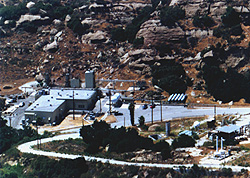 re-evaluated immediately, that the health of Rocketdyne nuclear
workers continue to be tracked and that similar studies by conducted on
nuclear workers elsewhere in the country. re-evaluated immediately, that the health of Rocketdyne nuclear
workers continue to be tracked and that similar studies by conducted on
nuclear workers elsewhere in the country.
-
- Researchers and health officials were
scheduled to brief Rocketdyne workers on the study's findings at meetings
this morning, and the community at meetings tonight and Friday night.
-
- "This study does not show that you
have a higher risk of cancer living in the surrounding area," one
source said. "This study was strictly done with workers who had individual,
day-to-day exposure. Anyone living in the homes and nearby communities
should not be alarmed by the study's findings."
-
- However, the report calls for a review
to determine if further study of the neighboring community is warranted.
-
- One of the things that prompted the exhaustive
worker study was a 1990 review of cancer registry data in the five census
tracts closest to the field laboratory that found elevated levels of bladder
cancer.
-
- Later analysis of the findings by state
epidemiologists found no connection between the elevated bladder cancer
levels and Rocketdyne operations. The report said there was no reason to
conduct health studies among nearby residents.
-
- However, community activists and state
legislators called for the worker study, saying it would help determine
whether further health studies of area residents are needed.
-
- Rocketdyne Won't Comment (snips)
-
- Nuclear History
-
- (snips) Among their key findings: 1.
Workers exposed to external radiation had higher than expected death rates
from leukemia, lymphoma and lung cancer
-
- 2. Increased doses of internal radiation
raised the death rates for a number of cancers, including of the mouth,
esophagus and stomach.
-
- 3. Death rates for all cancers increased
as external radiation doses increased.
-
- Despite these findings, officials noted
that even with the increased risks from radiation exposure, the workers
as a group had relatively good health compared to the general population.
(KK: Of course, 27.3% WERE dying of cancers directly related to the radiation
the workers were exposed to,.)
-
- State health officials would not publicly
respond to the study's findings. But one official said they were moving
aggressively to address the issue by briefing workers and dispatching researchers
to present a report to the Energy Department.
-
- The study could have wide-ranging impacts
on the nation's nuclear industry. An oversight panel formed to keep tabs
on the study has recommended that the current limits on radiation exposure
be reviewed in light of the findings, documents show.
-
- UCLA and state health officials are set
to publicly discuss the findings of the study at two meetings at the Simi
Valley Raddison Hotel, 999 Enchanted Way, Simi Valley. The meetings are
scheduled for 7 p.m. today and 7 p.m. Friday.
-
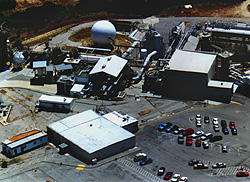 The Santa Susana Field Laboratory has
served as a main rocket engine testing site for the nation's space programs
as well as provided a remote site for decades of nuclear research. The Santa Susana Field Laboratory has
served as a main rocket engine testing site for the nation's space programs
as well as provided a remote site for decades of nuclear research.
-
- Located in the Simi Hills three miles
west of Chatsworth, the 2,600-acre complex was the test site for virtually
all the rocket engines that powered humans into orbit and finally to the
moon in the 1960s.
-
- During the 1970s and 1980s it was well
known in the west San Fernando Valley for its thunderous test of space
shuttle main engines.
-
- But for decades a cloak of secrecy shrouded
the U.S. Department of Energy's 290-acre nuclear research facility in 20
buildings at the western edge of the field lab on cliffs overlooking Simi
Valley,
-
- Nearly all of the nuclear facilities
have been torn down, and the radioactive materials and wastes removed to
licensed disposal sites out of the state. But at its height, Rocketdyne
and its predecessor company, Atomics International, operated as many as
16 nuclear reactors at the site.
-
- The Rocketdyne Division, which was owned
by Rockwell International until its sale to Boeing North America this year,
also operated Hot laboratory licensed by the U.S. Nuclear Regulatory Commission
to strip the plutonium out of spent nuclear power plant fuel rods.
-
- The company also operated a plant to
fabricate nuclear fuel rods at its De Soto Avenue complex in Canoga Park
during the 1960s.
-
- All of the nuclear facilities at Santa
Susana have been retired and most have been dismantled and decontaminated.
-
- The final phase of a $55 million nuclear
cleanup at the site will be to dismantle and decontaminate the Radioactive
Materials Disposal Facility where nuclear waste was packaged for shipping
to disposal sites.
|